

-- Michael North, Art and the Public Sphere
Perhaps the most intriguing thing about the solitary soldier monuments is that there are so many of them and that they all look basically the same. The statues are twenty-five feet high on average.2 The soldiers stand in a classical "contrapposto" position with a rifle held like a staff in hand, in front or to the side of the body. The Confederate statues were outfitted with canteen, bedroll, and other military accoutrements, and often wore a wide brimmed hat which was the only feature that made them distinguishable from Union statues. 3 In every other way, the Confederate statues were virtually identical to Union statues. In fact, Foster tells us that "As time went on, more and more of the soldiers were mass-produced models purchased from monument companies."4 He goes on to describe the reaction to them at the time:
In 1915 North Carolina editor Clarence Poe claimed that most of these monuments did little to make "anybody's heart beat faster" or give "any child a vision of the spirit, heroism and pathos of our Civil War period." Later, William Alexander Percy, who grew up among the monuments, damned them as "pathetic" and unworthy of the men they honored. At the very least, ....they lacked the passion of the war.5 |
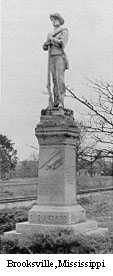 |
|
Additionally, the monuments' proliferation throughout the South only adds to their being nearly indistinguishable and devoid of the power to evoke emotion, patriotism, or a sense of history. For the repetition of the image strips it of its uniqueness and
thus its power for sincere meaning. All of these deficiencies suggest that the significance of the monuments lie somewhere other than their immediate appearance.
ReconstructionThe Confederate monument takes some of its greatest significance from the significance of building, of creating spaces, and of the public sphere, in the time of Southern reconstruction. By reconstruction, I mean not only the restorative plan and period of 1865-1875, but the activity of reconstruction that continued beyond that time. Because the destruction of the South was one of the objectives and effects of the war, its meaning far transcends the mere significance of buildings and space. The destruction of the South meant the defeat of its heritage and lifestyle, politics, culture, people, and Cause. Thus, the structures and spaces of the South were politically, ideologically, and emotionally charged points of contention. The mere significance of buildings and space was, and still is for the purposes of this analysis, actually very great. It is representative of the reconstruction of the entire South in that it was both a part of it, and a symbol of it. This makes the word "reconstruction" an apt term for the overhaul of the South. Yet, John Ezell, author of The South Since 1865, reveals the failure of the term to capture the import of the time and events: reconstruction had to be more than mere rebuilding. There could be no thought of replacing the old forms, for their destruction had been one of the primary objectives of the war. Therefore, "Reconstruction" was a misnomer, an impossibility. There could be nothing less than a revolution - economically and socially with the abolition of slavery, and politically with the South surrendering its dominance of the national government for the first time in the nation's history.6What was under contention in the rebuilding of the post-Civil War South (its buildings and spaces, rituals and ceremonies as well as its institutions, government, and religion) was this revolution, and the power to shape that revolution and thus the South itself. Monuments and dedications were part of the vocabulary of reconstruction, and to create them was to articulate the revolution and recreate the South. | |
| After the war there was some question as to how the South should be treated by the federal government. Radical Republicans argued that the South had been treasonous and therefore forfeited its role and power as a state and became, rather, a territory under the power of the Congress. Some even advocated confiscation of property, enforced exileand execution.7 Such sentiment suggests how intense the tensions were at the time and how important an affair reconstruction was. |  |
While the radical Republicans did not have their way, much of the reconstruction of the South, in buildings as well as in politics and culture, was the work of the North. Industrialization itself was, in a sense Northern. For, one element of the South which the Confederacy fought to protect was its agricultural lifestyle. In a sense, the industrialization of the South was its attenuated defeat. In addition, The Freedman's Bureau supplied special courts to help the blacks make work contracts with white managers. The Bureau also sent countless missionaries into the South to aid the blacks. Perhaps most importantly, while business and industry grew in the South, it was Northern capital that made this possible: The continued and accelerated flow of Northern capital brought an increasing degree of control. While the number of Southern businessmen increased, all too often they were the agents of the North. J.P. Morgan was the biggest name in Southern railroads, the iron and steel industry was dominated by United States Steel, and the oil industry paid homage to the Mellons and Rockefellers. Even the one Southern financial giant, James Duke, transferred his headquarters to New York. Still, too, the South continued to send the products of its mines, farms, and forests North or abroad in the form of raw or crudely processed materials. The colonialism of which pre- war Southerners had complained had not been ended but had merely shifted emphasis.8 In the context of reconstruction after the Civil War, Confederate monuments were one of the few means by which Southerners asserted their own collective will and voice. These monument sites are the sites of a perpetuated South in the midst and wake of its dominance by the North. As such, they are sites which challenge the authority of the this domination. W. J. T. Mitchell explains this dynamic, quoting artist, Vito Acconci: Public art "proper," whether the hero on the horse or the abstract ornament in the urban corporate plaza, may well be....a contradiction in terms....As a contradiction, its function is, in Vito Acconci's words, "to de-design...like a wart, on a building...like a leech to an empty wall...like a wound" or "a burrow or a foxhole or a lair." This realistic, critical, anti-utopian view of public art as something that "comes in through the back door like a second-class citizen" is what makes possible, in Acconci's view, its function as "the voice of marginal cultures, as the minority report, as the opposition party."9According to Acconci, part of the reason why public art is so often the voice of the minority is because it is a hundred times less expensive than architecture.10 This has fitting application to the South under reconstruction. It may explain the wide-spread popularity of the local Confederate monument and its affirmation of the Old South and Lost Cause. It was certainly difficult enough to come up with the money for the monuments, as so many programs testify through accounts of how the monuments were funded. The monuments provided a means of contradicting the effect of reconstruction which, both literally and figuratively, represented the domination of the North. Each monument, and the gesture created by the monuments taken as a whole, are like wounds or scars on a Northernized, modernized, incorporated South. They force the viewer to remember the conflict between the North and the South and the fact that it was settled by war and not by compromise or agreement. They remind the viewer of a lost South, making them aware of its present absence in the reconstructed South. In the words of Michael North, the monuments "...place their viewers in a public space that is articulated in terms of political controversy so that to view the piece is not simply to experience space but also to enter a debate."11 The reconstruction of the South provides the terms of political controversy which articulate the public sphere as a sphere of debate. By placing the monuments in the public sphere, Southerners created portals to the debate and spaces of contradiction. This principle speaks to the significance of the placement of so many of these monuments on court-house lawns. The court-house lawn was not only a public space, but a space associated with government and justice. As such, the placement of Confederate monuments in these spaces reminds the viewer of the injustice, stifling of state government, and tyranny of the federal government which the South saw as the outcome of the war. Thus, they destroy the illusion of a unified nation which reconstruction sought to achieve. They prevent the South, reconstructed in the image of the North, from being whole. |
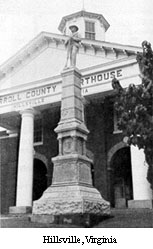 |
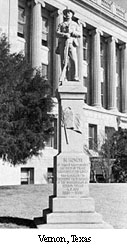 |
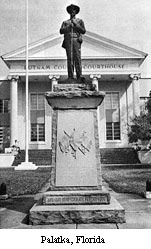 |
The Confederate monuments were also placed in local spaces. It seems significant that, rather than
expressing their voice in one large project, Southerners chose to express it in local spheres and as a
local voice in their use of monuments. This has several ramifications. First, it reaffirms the
importance of the local, of community, and of the state. Many monuments were dedicated to the
Confederate dead of a certain town, regiment, or state. These gestures correspond with the politics
of the Confederacy which sought to protect state rights. Thus, the local nature of the monument
vindicates the Lost Cause. It also perpetuates the debate over state rights and voices the Southern
opinion which was kept from fruition by defeat in the war. Michael North's statement about the
work of artist Hans Haacke is a propos:
Haacke's work manages to superimpose one public space on another and in so doing suggests a community whose nature is open to question, whose history presents certain alternatives for choice.12Confederate monuments are public spaces representing the Old South, superimposed upon public spaces of the New, reconstructed South. They, too, render the community open to question. Furthermore,the local nature of the monuments makes the act of memorialization seem more sincere. For, the local monument has its origin in local committees and in individuals. The dedication programs even name these people. The emphasis is on the idea that the monuments express the feelings, ideas, and needs of the people, the will of a majority or the public. The proliferation of local monuments adds to this effect. The proliferation makes the voice of the monuments the voice of the entire region, while the local nature of the monuments preserves the sense of the sincerity of that voice which might otherwise be lost in one regional gesture. The monuments thus seem to represent the voice of the public. Yet the voice remains marginal because portrayed as stifled through its expression in the context of a reconstructed New South. Therefore, the monuments also portray the power of reconstruction, of the North, and the federal government, as a power which violates the will of the public held sacred in a democracy. The monuments thus reveal the hypocrisy of the Union cause. They also define the majority public sphere as a sphere of the tyranny of the North.
|
| The proliferation of the local Confederate monument also makes it into a symbol. As an image is used over and over again to connote the same or similar meanings, as the solitary soldier monument was, it becomes a symbol for those meanings. Additionally, the very image lends itself to symbolic use. It is an idealized rendering of the Confederate soldier. Unlike statues of Jackson or Lee, the solitary soldier is no one specific. The statue is, in a sense, an empty image which the viewer can fill with a wide range of meanings and significance. For example, the soldier can represent any soldier, including loved ones lost in the war. With his simple nobility, he is a vessel for virtue, courage, dedication, honor. If the image were any more complicated than it is, it might not be as ideal an image for symbolic representation. Furthermore, because of its anonymity, the solitary soldier monument symbolized individuality. It therefore reaffirmed the value of the self-sacrificing and self-sufficient gentleman. Thus, the monument was a symbol and space of refuge from and contradiction of the undermining of the individual caused by industrialization and incorporation. |  |
Finally, the solitary soldier monument also symbolized the financial power of the South and its
local communities. As Foster stated, the solitary soldier monument came to be mass produced.
This suggests the commodification of the monument, as does its proliferation. Dedication
programs described the lengths sponsors went to, to fund the monuments. It could take as many as
six years to fund and erect a monument.13 For this reason, the memorialization
increased with time as the South recuperated financially from the war.14 Lists of
donations show that funding often came from private individuals throughout the community,
evincing their dedication to both the pre and post-Civil War South. Newspapers would run
advertisements for funding and sponsoring organizations would hold public lectures and bazaars to
raise money.15 That people throughout the South had to go to such great lengths to
fund monuments makes them symbols of financial growth and stability.
Furthermore, as Mitchell suggests,
financial status related to the power to participate in the public sphere
and thus to power and
authority in general:
Real participation in the public sphere involves more than tokenism: it involves full economic participation.16The statue became a symbol of the South's financial stability, participation and power in the public sphere, sense of community, and dedication to the Confederacy and its soldiers. |
|
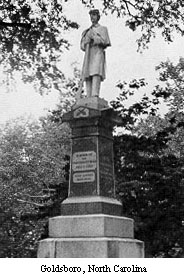 |
The proliferation of the monument had one more effect. It created a veritable landscape of Southern voice and identity. Because the monuments were local as well as regional efforts, their presence permeated and still does permeate the South in a very visible way. The people and the monuments interrelate in the way that people and their environment or the landscape interrelate. The monuments, like the landscape, surround, affect, and influence people. The monuments as a whole, surround and engulf people by virtue of their number and thus the large size of the space in which they exist. In doing so, they define the world in which the people exist. The monuments being highly symbolic and ideological, define a world in social, cultural, and political terms. They create a world in which white men have the power to express themselves in a way women and black people do not. They have the power to create and define the public sphere, community, and identity. The monumental landscape is a world of the past but also the tension of the past with the present. It is a world of gentility with clear boundaries, from class divisions to cultural and societal values, between what is real and what is not. These characteristics limit the ways in which the people within the landscape may define themselves, interrelate, express themselves, the power they may claim, and the boundaries they must break to escape these restrictions. |
| Yet, all of this is achieved subtly through the pervasiveness, sheer size and scope of the monuments' influence. The monuments' messages are not articulated overtly but are all the more effective because subtle and thus difficult to undermine. Furthermore, such influences seem natural and truthful because they surround people to such an extent as to deprive them of the sense that the landscape could be other than it is. The monuments are made to interrelate with the viewers in these ways by virtue of their proliferation and presence in the public sphere. It is interesting to note that, like White City, Confederate monuments affect the viewer by creating an environment which surrounds them. While the environment created by the monuments is not as unified as that of White City but rather displays contradiction, it still operates under the same principle of social engineering that through constructing a people's environment one can construct the people. The monuments sought to construct a people dedicated to at least remembering if not preserving and perpetuating the lifestyle and values of the Old South, and the Cause of the Confederacy. | 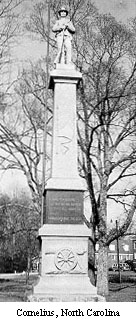 |
|
The Monument as the CenterThe space is public, but the people in it don't function as a public. In order for public space to be a gathering place, where all the people are gathered together as a public, it needs a gathering point. To be seen and read as a public, to act and/or be used as a public, the dots (people) have to form a circle, as if around a point; or they have to form a line, as if toward a point.17The point of the monument was to bring people together and create community, as it certainly did on dedication days. Furthermore, it was instrumental in creating a public and a public sphere that was decidedly Southern. Michael North illuminates this relationship: As the aesthetic focus shifts from the object to the experience it provokes, the relationship of the two goes beyond mere implication: the public becomes the sculpture.18Both at its dedication and since, the Confederate monument shifts the aesthetic focus from itself to the activity of collective and individual remembering which it provokes. In doing so, it creates a public, creating its own sense of identity. Monuments, both individually and collectively, continue to function as a gathering place of thought if not people. While Trachtenberg argues that the crises surrounding the World's Fair, such as the Pullman strike, reveal the failure of social engineering to create a happy, unified, ordered people. Yet, the Confederate monument dedications serve as an example of how manipulations of the public sphere's appearance and spatial arrangement could create and shape a community, if only for a day. Yet, I believe the effect of the monument far outlasts its dedication day. For, the South has not forgotten its past. Nor can the monuments cease to inform the public's sense of itself and its surroundings as long as their placement in the public sphere is secure. |
|
|
|
|
|
|
|
|
|